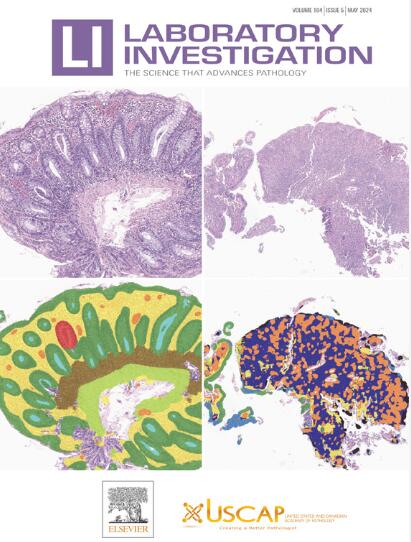Siglec Ligand Immunohistochemistry Reveals Association With Immune Exclusion and Survival
IF 4.2
2区 医学
Q1 MEDICINE, RESEARCH & EXPERIMENTAL
引用次数: 0
Abstract
Sialic acids are overexpressed in many cancers, and binding of sialic acid via sialic acid binding immunoglobulin-like lectins (Siglecs) may contribute significantly to immune evasion and cancer progression. This important resistance mechanism in the tumor immune microenvironment has been understudied, partially due to the lack of useful reagents. Here, we developed and optimized an immunohistochemistry staining protocol for novel reagents that detect 3 types of Siglec-engaging sialoglycans (HYDRA-3, -7, and -9, which detect sialoglycans recognized by Siglec-3, -7, and -9, respectively) in the tumor immune microenvironment. We evaluated HYDRA staining across 10 different cancer types across whole slides, finding that HYDRA-9 exhibited the highest overall staining range, with HYDRA-3 and -7 showing lower to moderate staining across all tested tumor types. To correlate HYDRA staining patterns and immune infiltration in melanoma, we stained melanoma tissue microarrays with the 3 HYDRA reagents and compared HYDRA staining profiles with a 6-plex multiplex immunofluorescence panel targeting CD8, CD163, FoxP3, PD1, PDL1, and Sox10/S100. Siglec-3 and -9 sialoglycan ligand expression negatively correlated with CD8 T cell infiltration (r = −0.28/P = .002 and r = −0.29/P = .001, respectively), particularly at the tumor-stromal interface (r = −0.37/P < .001 and r = −0.44/P < .001, respectively). Additionally, a high ratio of Siglec-3 and -9 ligand expression at the tumor-stromal interface versus the tumor core was associated with reduced overall survival (Hazard’s ratio: 2.60 and 2.11, respectively), whereas CD8 infiltration was not associated with survival outcomes in our cohort. Taken together, the expression levels and spatial distribution of Siglec-engaging sialoglycans may play a role in patient prognosis, potentially representing a biomarker of survival that is independent of conventional metrics of an inflamed tumor microenvironment. This study highlights the need for further investigation of Siglec ligand expression as a predictive and prognostic biomarker of treatment response and resistance.
Siglec配体免疫组化显示与免疫排斥和生存有关。
唾液酸在许多癌症中过度表达,唾液酸通过唾液酸结合免疫球蛋白样凝集素(Siglecs)结合可能对免疫逃避和癌症进展起重要作用。肿瘤免疫微环境(TIME)中这种重要的耐药机制尚未得到充分研究,部分原因是缺乏有用的试剂。在这里,我们开发并优化了一种免疫组织化学(IHC)染色方案,用于检测三种类型的siglece唾液聚糖(HYDRA-3, -7和-9,分别检测siglec3, -7和-9识别的唾液聚糖)。我们在整个载玻片上评估了HYDRA在10种不同癌症类型中的染色情况,发现HYDRA-9在所有测试的肿瘤类型中表现出最高的总体染色范围,而HYDRA-3和-7在所有测试的肿瘤类型中表现出较低到中等的染色。为了将HYDRA染色模式与黑色素瘤中的免疫浸润联系起来,我们用3种HYDRA试剂对黑色素瘤组织微阵列(tma)进行染色,并将HYDRA染色谱与靶向CD8、CD163、FoxP3、PD1、PDL1和Sox10/S100的6-plex多重免疫荧光面板进行比较。Siglec-3和-9唾液聚糖配体表达与CD8 T细胞浸润呈负相关(r=-0.28/p=0.002和r=-0.29/p=0.001),特别是在肿瘤-基质界面(r= -0.37/p)
本文章由计算机程序翻译,如有差异,请以英文原文为准。
求助全文
约1分钟内获得全文
求助全文
来源期刊

Laboratory Investigation
医学-病理学
CiteScore
8.30
自引率
0.00%
发文量
125
审稿时长
2 months
期刊介绍:
Laboratory Investigation is an international journal owned by the United States and Canadian Academy of Pathology. Laboratory Investigation offers prompt publication of high-quality original research in all biomedical disciplines relating to the understanding of human disease and the application of new methods to the diagnosis of disease. Both human and experimental studies are welcome.
 求助内容:
求助内容: 应助结果提醒方式:
应助结果提醒方式:


